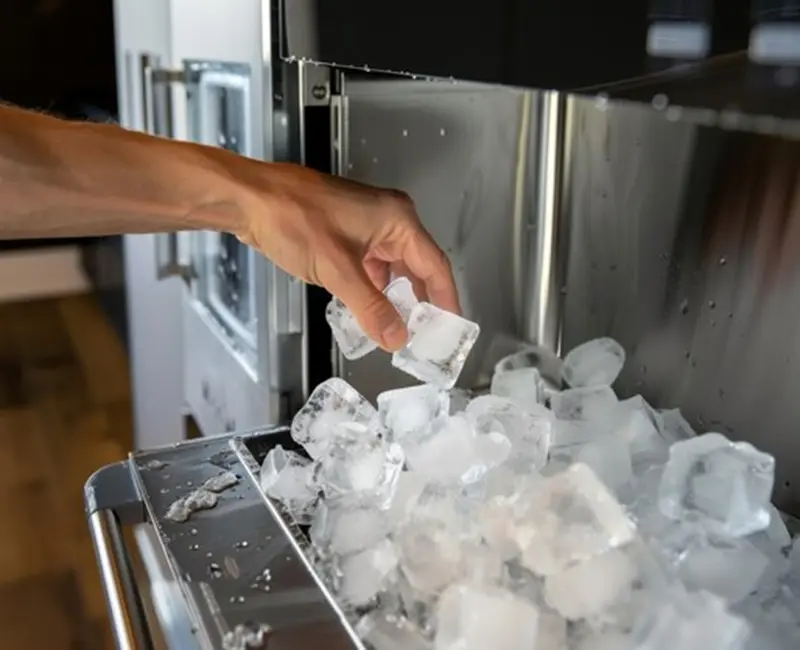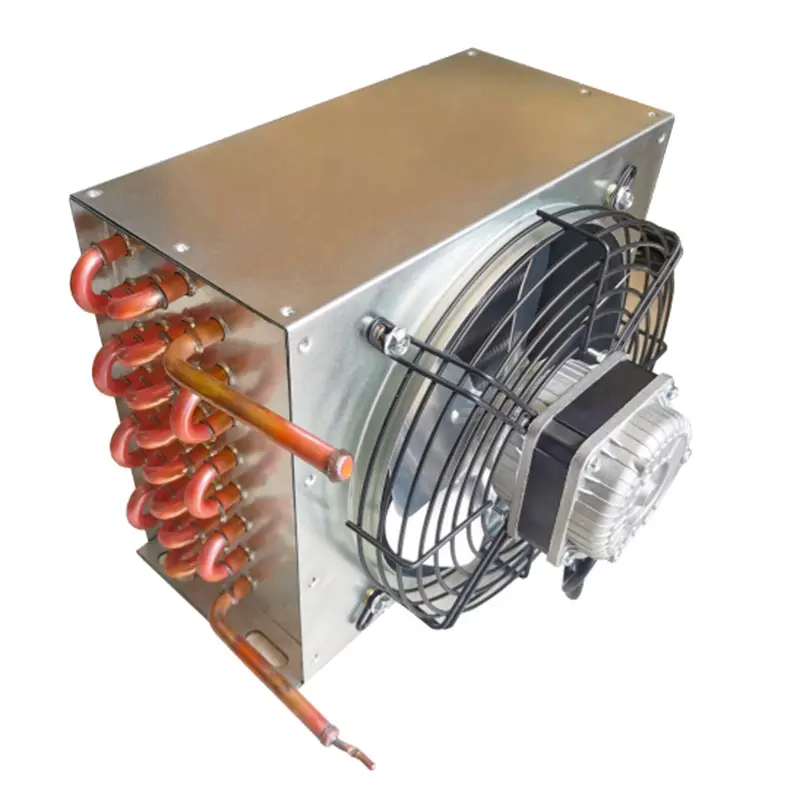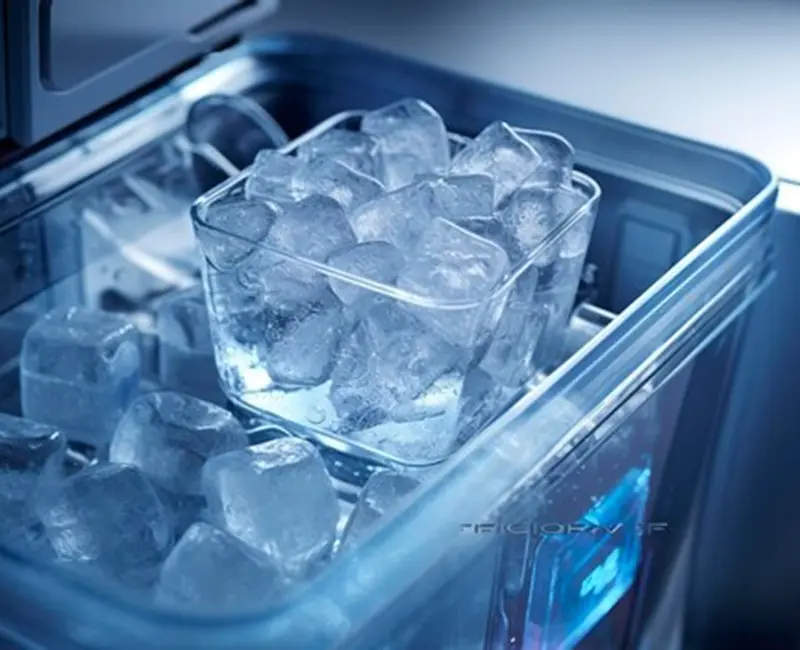What are the applications of copper tube aluminum fin heat exchangers?

I see copper tube aluminum fin heat exchangers as a cornerstone of modern thermal systems. Their design combines copper's excellent thermal conductivity with aluminum's lightweight and corrosion-resistant properties. This synergy ensures efficient heat transfer and durability, making them ideal for demanding applications.
These Copper Fin Heat Exchangers dominate industries like HVAC, automotive, and aerospace. The HVAC sector, in particular, has experienced rapid growth due to the increasing demand for energy-efficient heating and cooling solutions. Compared to other types, copper tube aluminum fin heat exchangers offer superior performance.
For instance, aluminum-tube heat exchangers exhibit 4%-12% lower heat transfer and 7%-9% lower heat transfer coefficients than copper-tube models.
| Heat Exchanger Type | Heat Transfer Performance | Heat Transfer Coefficient | Cost Comparison |
|---|---|---|---|
| Copper Tube - Aluminum Fins | Baseline | Baseline | Higher Cost |
| Aluminum Tube - Aluminum Fins | 67% higher | 4%-12% lower | 8% of copper cost |
| Aluminum Tube - Copper Fins | 4%-12% lower | 7%-9% lower | Higher Cost |
The versatility of copper tube aluminum fin heat exchangers ensures their relevance across diverse applications, from refrigeration to renewable energy systems. Their efficiency and reliability make them indispensable in modern engineering.
Key Takeaways
- Copper tube aluminum fin heat exchangers use copper for heat transfer and aluminum for being light, making them strong and efficient.
- These exchangers are important in cooling, heating, and green energy systems. They save energy and lower costs.
- They resist rust and are light, which makes them easy to install and fix. This makes them great for homes and factories.
- These exchangers can be adjusted for different uses, working well in tough places like cars and factories.
- Using these exchangers helps the planet by saving energy and cutting pollution in modern heating and cooling systems.
Applications in HVAC Systems

Residential and Commercial Heating and Cooling
I see copper tube aluminum fin heat exchangers as a game-changer in residential and commercial heating systems. Their design ensures efficient heat transfer, which directly improves energy efficiency. Here’s why they excel in these applications:
- Corrosion Resistance: The combination of copper and aluminum resists degradation, ensuring long-lasting performance.
- Lightweight Design: Aluminum fins reduce the overall weight, simplifying installation and lowering operational costs.
- Versatility: These heat exchangers adapt to various heating and cooling needs, making them suitable for diverse settings.
- High Thermal Conductivity: Copper’s exceptional ability to conduct heat allows for rapid temperature regulation.
- Extended Surface Area: Aluminum fins maximize the surface area for heat dissipation, optimizing thermal exchange.
- Durability: The robust materials reduce maintenance needs and extend the lifespan of heating systems.
This combination of features makes these heat exchangers indispensable for maintaining comfortable indoor environments while minimizing energy consumption.
Ventilation and Air Conditioning Units
Ventilation and air conditioning units rely heavily on copper tube aluminum fin heat exchangers for their efficiency and reliability. These systems are integral to units such as:
- Precision air conditioners
- Cabinet air conditioners
- Duct air conditioners
- Chillers
- Packaged rooftop units
A water-to-air heat exchanger, for example, transfers heat from hot water running through copper tubes to air passing over aluminum fins. This design ensures optimal thermal performance in both residential and industrial HVAC systems.
Copper tube aluminum fin heat exchangers are also widely used in industrial air conditioning unit coil replacements, highlighting their versatility and reliability.
Role in Thermal Management and Energy Efficiency
Thermal management is critical in HVAC systems, and copper tube aluminum fin heat exchangers play a pivotal role. Their efficient heat transfer capabilities ensure consistent temperature control. Copper’s high thermal conductivity facilitates rapid heat transfer, while aluminum fins provide an extended surface area for heat dissipation. The fin design promotes turbulence, further enhancing heat exchange rates.
Additionally, these heat exchangers outperform alternatives due to their superior conductivity, durability, and corrosion resistance. Their lightweight nature reduces structural strain, optimizing energy efficiency and lowering operating costs. As the HVAC industry continues to prioritize energy-efficient solutions, these heat exchangers remain at the forefront of innovation.
Applications in Refrigeration
Commercial Refrigeration Systems
Copper tube aluminum fin heat exchangers play a vital role in commercial refrigeration systems. Their design ensures efficient heat transfer, durability, and adaptability, making them indispensable in applications like supermarkets, restaurants, and industrial refrigeration units. These systems often require consistent cooling performance to maintain product quality and safety.
The combination of copper tubing and aluminum fins creates a highly effective heat transfer system. Copper’s excellent thermal conductivity ensures rapid heat exchange, while aluminum fins maximize the surface area for heat dissipation. This synergy results in reliable and energy-efficient cooling solutions. Additionally, the lightweight nature of aluminum fins simplifies installation and reduces structural strain, which is especially beneficial for large-scale refrigeration setups.
| Advantage | Description |
|---|---|
| Heat Transfer Efficiency | The combination of copper tubing and aluminum fins creates a highly effective heat transfer system. |
| Durability and Corrosion Resistance | Copper and aluminum together provide increased longevity and resistance to degradation. Copper resists corrosion, while aluminum forms a protective oxide layer. |
| Lightweight Nature | Aluminum fins are lightweight, easing installation and minimizing strain on structures. |
| Versatility | These systems can be customized for various heat transfer applications and sizing needs. |
| Ease of Maintenance | Smooth surfaces allow for easy cleaning, ensuring optimal performance and longevity. |
Freezers, Cold Rooms, and Display Cabinets
Freezers, cold rooms, and display cabinets rely heavily on copper tube aluminum fin heat exchangers for their superior thermal performance. Copper tubing enhances heat transfer efficiency, while aluminum fins increase the heat exchange surface area. This combination ensures optimal cooling, even in demanding environments.
The design of these heat exchangers promotes airflow and maximizes surface contact, leading to efficient heat dissipation. This reduces heat loss and ensures consistent temperature control, which is critical for preserving perishable goods. Whether in medical ultra-low temperature refrigerators or supermarket display cabinets, these heat exchangers deliver reliable performance.
Benefits in Food Storage and Preservation
Efficient refrigeration is essential for food storage and preservation. Copper tube aluminum fin heat exchangers contribute significantly to maintaining the freshness and quality of stored goods. Their ability to regulate temperature precisely ensures that food remains at the ideal conditions, preventing spoilage.
The robust materials used in these heat exchangers resist corrosion and degradation, ensuring long-term reliability. Their lightweight design also facilitates easy maintenance, which is crucial for minimizing downtime in commercial settings. By optimizing energy efficiency and providing consistent cooling, these heat exchangers support sustainable and cost-effective food storage solutions.
Applications in Industrial Processes
Heat Recovery Systems
I find heat recovery systems to be one of the most impactful applications of copper tube aluminum fin heat exchangers. These systems excel in capturing and reusing waste heat, which would otherwise be lost. For instance, a water-to-air heat exchanger transfers heat from hot water flowing through copper tubes to air passing over aluminum fins. This design ensures efficient energy recovery in industrial and HVAC systems.
In industries like steel and glass, high-temperature exhaust gases contain significant heat. Copper tube aluminum fin heat exchangers recover this heat to preheat combustion air, reducing fuel consumption and enhancing energy efficiency. They also play a crucial role in energy recovery for air conditioning systems by facilitating heat exchange between exhaust and fresh air. Additionally, in steam systems, they recover latent heat from condensation, which can then be used for drying processes. These applications demonstrate their versatility and effectiveness in reducing energy waste.
Process Cooling and Heating
Copper tube aluminum fin heat exchangers significantly enhance process cooling and heating in industrial settings. Their design optimizes thermal exchange rates, making them ideal for applications like air conditioning and refrigeration. Copper’s high thermal conductivity ensures rapid heat conduction, while aluminum fins provide an extended surface area for heat dissipation. This combination delivers efficient heat transfer, which is critical for maintaining precise temperature control in industrial processes.
I’ve observed their widespread use in industries requiring consistent cooling or heating, such as chemical manufacturing and food processing. These heat exchangers not only improve operational efficiency but also reduce energy consumption. Their lightweight nature simplifies installation and minimizes structural strain, making them a practical choice for large-scale industrial applications.
Use in Manufacturing and Production Facilities
Manufacturing and production facilities rely heavily on copper tube aluminum fin heat exchangers for their durability and performance. These heat exchangers support various processes, including heat recovery, cooling, and heating, ensuring optimal thermal management. In industries like automotive and electronics, they maintain the required temperatures for equipment and materials, preventing overheating and ensuring product quality.
Their robust construction resists corrosion and wear, which is essential in demanding environments. Despite the higher initial cost compared to alternatives, their superior heat transfer efficiency and long-term reliability make them a cost-effective solution. By reducing energy consumption and operational costs, these heat exchangers contribute to sustainable and efficient manufacturing practices.
Applications in Automotive Systems

Vehicle Radiators and Engine Cooling
Copper tube aluminum fin heat exchangers play a critical role in vehicle radiators and engine cooling systems. I’ve observed how their design ensures efficient heat dissipation, which is essential for maintaining optimal engine performance. These heat exchangers excel due to several key features:
- Excellent Thermal Conductivity: Copper tubing facilitates rapid heat transfer, preventing engine overheating.
- Maximized Heat Exchange Surface Area: Aluminum fins enhance thermal energy transfer to the air, promoting effective cooling.
- Durability and Corrosion Resistance: The combination of copper and aluminum ensures longevity and reduces maintenance needs.
- Lightweight Design: Aluminum fins contribute to a lighter system, improving vehicle efficiency and ease of installation.
These features make them indispensable for modern automotive cooling systems. Regular maintenance, such as cleaning the fins and inspecting for corrosion, ensures peak performance and extends the lifespan of the system.
Air Conditioning Systems in Automobiles
Automotive air conditioning systems rely heavily on copper tube aluminum fin heat exchangers for their efficiency and reliability. I’ve noticed how these systems ensure rapid cooling, even in extreme temperatures. The copper tubes transfer heat effectively, while the aluminum fins maximize airflow and heat dissipation. This combination creates a compact yet powerful cooling solution.
Maintenance is straightforward. The smooth surfaces of the copper tubes allow for easy cleaning, while aluminum fins can be cleaned with a soft brush or compressed air. Regular upkeep prevents dust buildup and ensures unobstructed airflow, maintaining the system’s efficiency over time.
Enhancing Vehicle Thermal Efficiency
Copper tube aluminum fin heat exchangers significantly enhance vehicle thermal efficiency. Their lightweight design reduces the overall weight of the vehicle, improving fuel economy. The superior heat transfer capabilities of copper and aluminum ensure consistent temperature regulation, which is vital for both engine performance and passenger comfort.
Monitoring for pressure drops and cleaning the system regularly are essential for maintaining efficiency. These practices prevent blockages and ensure optimal heat transfer. By integrating these heat exchangers, automotive manufacturers achieve better energy efficiency and reduced emissions, aligning with modern sustainability goals.
Applications in Renewable Energy
Solar Thermal Systems
I see copper tube aluminum fin heat exchangers as a cornerstone in solar thermal systems. Their design ensures efficient heat transfer, which is critical for capturing and utilizing solar energy effectively. The combination of copper tubing and aluminum fins creates a highly efficient system that maximizes energy absorption and transfer. This efficiency supports the performance of solar water heaters and other thermal applications.
These heat exchangers offer several advantages:
- Heat Transfer Efficiency: Copper’s high thermal conductivity ensures rapid energy transfer, while aluminum fins enhance dissipation.
- Durability and Corrosion Resistance: Copper resists corrosion, and aluminum forms a protective oxide layer, ensuring longevity.
- Lightweight Design: Aluminum fins reduce weight, simplifying installation and minimizing structural strain.
- Versatility: These systems adapt to various applications, making them suitable for diverse renewable energy setups.
By integrating these heat exchangers, solar thermal systems achieve higher efficiency and reliability, contributing to sustainable energy goals.
Geothermal Heat Pumps
Geothermal heat pumps rely on copper tube aluminum fin heat exchangers for their ability to transfer heat efficiently between the ground and indoor spaces. I’ve observed how these systems utilize the earth’s stable temperature to provide heating and cooling solutions. The copper tubing ensures rapid heat conduction, while aluminum fins maximize the surface area for energy exchange.
These heat exchangers enhance the performance of geothermal systems by:
- Improving energy capture and transfer rates.
- Reducing operational costs through efficient thermal management.
- Offering durability and resistance to environmental degradation.
Their lightweight design also simplifies installation, making them a practical choice for residential and commercial geothermal applications.
Contribution to Sustainable Energy Solutions
Copper tube aluminum fin heat exchangers play a vital role in advancing sustainable energy solutions. Their high thermal conductivity and efficient design optimize energy conservation, which is essential for reducing environmental impact. Aluminum fins provide an extended surface area for heat dissipation, enhancing overall system performance.
These heat exchangers contribute to sustainability by:
- Enhancing energy efficiency in renewable systems like solar and geothermal setups.
- Reducing operational costs through lightweight and durable materials.
- Supporting long-term reliability with corrosion-resistant properties.
Their integration into renewable energy systems aligns with global efforts to reduce carbon emissions and promote energy efficiency. By maximizing energy capture and minimizing waste, these heat exchangers support the transition to a more sustainable future.
I see copper tube aluminum fin heat exchangers as indispensable in modern thermal systems. Their durability stems from copper’s corrosion resistance and aluminum’s protective oxide layer. Lightweight aluminum fins simplify installation, while modular designs allow customization for diverse applications. These heat exchangers align with energy efficiency trends by reducing refrigerant use and enhancing thermal performance. Industries increasingly demand eco-friendly solutions, and these systems meet that need. As sustainability and innovation drive global markets, I believe their role in HVAC, refrigeration, and renewable energy systems will only grow stronger.
FAQ
What makes copper tube aluminum fin heat exchangers efficient?
I believe their efficiency lies in copper's high thermal conductivity and aluminum's lightweight, corrosion-resistant properties. Copper transfers heat rapidly, while aluminum fins maximize the surface area for dissipation. This combination ensures optimal heat exchange, making these systems highly effective in various applications.
How do these heat exchangers contribute to energy efficiency?
Copper tube aluminum fin heat exchangers enhance energy efficiency by reducing heat loss and optimizing thermal transfer. Their lightweight design minimizes structural strain, while their durability reduces maintenance needs. These features lower operational costs and support sustainable energy practices across industries.
Are these heat exchangers suitable for extreme environments?
Yes, they perform exceptionally well in extreme conditions. Copper resists corrosion, and aluminum forms a protective oxide layer, ensuring durability. I’ve seen them used in demanding applications like industrial processes and medical refrigeration, where consistent performance is critical.
Can these heat exchangers be customized for specific applications?
Absolutely. Their modular design allows customization to meet diverse requirements. I’ve observed their adaptability in HVAC systems, automotive cooling, and renewable energy setups. This flexibility makes them a versatile solution for various industries.
Why are these heat exchangers preferred in renewable energy systems?
Their high thermal conductivity and lightweight design make them ideal for renewable energy systems. Copper tube aluminum fin heat exchangers maximize energy capture and transfer, ensuring efficiency in solar thermal and geothermal applications. They align with sustainability goals by reducing energy waste and supporting eco-friendly solutions.


















